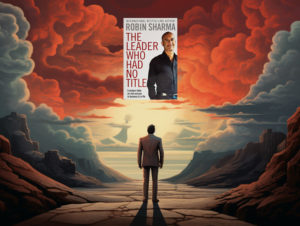“The Leader Who Had No Title” is a motivational book written by Robin Sharma. Published in 2010, the book presents a narrative about leadership and success, emphasizing that anyone in any position can be a leader. Sharma uses the story format to convey his principles, introducing readers to a variety of characters who impart wisdom about leadership, personal growth, and success.
Short Summary of The Book
“The Leader Who Had No Title” by Robin Sharma is a motivational fable that underscores the idea that anyone, regardless of their position or title, can exhibit leadership and make a significant impact. The story follows Blake Davis, who, through encounters with several mentors, learns invaluable lessons about leadership, personal success, and the power of authenticity. Each mentor imparts wisdom that challenges conventional notions of leadership, emphasizing that true leaders inspire through action, passion, and genuine connection, not just hierarchical status.
The book offers practical advice and strategies for personal growth and fostering a leadership mindset in everyday life.
Comprehensive Summary of “The Leader Who Had No Title”
My summary is based on the mentors the main character will meet and the lessons they will teach him on his way.
The History Teacher: Leadership Begins Within
Blake Davis, disheartened by his current job and life’s trajectory, meets Tommy Flinn, a former war veteran and history teacher. Tommy introduces Blake to the idea that leadership isn’t about titles but about our daily actions and attitudes. He emphasizes the importance of personal growth, continuous learning, and self-mastery. Tommy’s core lesson: “You can lead without a title.”
The CEO: Embracing Relationships and Teamwork
Next, Blake meets Anna, a CEO of a thriving company. Anna teaches him that building strong relationships is crucial for leadership. She stresses the importance of fostering a positive work environment, where team members feel valued and empowered. Anna’s mantra: “To be a great leader, be a great person.”
The Surfer: Adaptability and Embracing Change
On a beach, Blake encounters a professional surfer, Jackson. Jackson’s life lesson revolves around the importance of adaptability in leadership. Just as a surfer must adapt to changing waves, a leader must be flexible and embrace change, seeing challenges as opportunities for growth. Jackson’s insight: “Change is hard at first, messy in the middle, and gorgeous at the end.”
The Shoe-shiner: Passion and Excellence in Every Task
The final mentor is Cal, a shoe-shiner with an unmatched passion for his work. Cal’s dedication to excellence, even in a seemingly mundane job, demonstrates that every task, no matter how small, can be done with leadership. He believes in taking pride in one’s work and serving others with love and respect. Cal’s lesson: “Every job is a self-portrait of the person who did it. Autograph your work with excellence.”
Throughout these encounters, Blake undergoes a profound transformation, realizing that leadership is not confined to boardrooms or high-ranking titles. It’s about making a difference, showing up with authenticity, and leading with heart. The book concludes with Blake feeling rejuvenated, ready to apply the lessons he’s learned in his own life and workplace.
Context of The Book
Robin Sharma, the author of “The Leader Who Had No Title,” has always been passionate about leadership and personal development. The book was influenced by Sharma’s own experiences as a leadership consultant for various Fortune 500 companies and his observations of everyday leaders who made significant impacts without holding traditional leadership roles. The changing dynamics of the corporate world, where hierarchical structures were being challenged, and the rise of grassroots movements globally, also played a role in shaping the book’s central theme.
Comparison with Other Works
Sharma has written several books on leadership and personal mastery, including “The Monk Who Sold His Ferrari” and “The 5 AM Club.” While all his works emphasize personal growth, “The Leader Who Had No Title” stands out for its focus on leadership without authority. Unlike “The Monk Who Sold His Ferrari,” which delves into spiritual growth and finding one’s purpose, this book is more about everyday leadership and the impact of small actions.
Reception and Criticism
“The Leader Who Had No Title” was well-received for its fresh take on leadership, especially in the corporate world. Many readers found its message empowering, suggesting that anyone, regardless of their position, can exhibit leadership. However, some critics felt that the book was overly simplistic and did not delve deep enough into the complexities of leadership in larger organizational structures.
Comparative Analysis
Compared to other leadership books of its time, such as “Drive” by Daniel H. Pink, which focuses on what motivates us, or “Start with Why” by Simon Sinek, which emphasizes the importance of purpose in leadership, Sharma’s work is more of a narrative journey. It uses storytelling to convey its message, making it more accessible to a broader audience. While other books provide more of a theoretical framework, Sharma’s book offers practical lessons through the protagonist’s encounters.
Interesting Facts
- Inspiration from Real-life Encounters: Sharma’s interactions with successful leaders from various fields, including business magnates, sports personalities, and artists, influenced many of the lessons in the book.
- Global Reach: The book has been translated into more than 70 languages, showcasing its universal appeal and relevance across different cultures.
- Incorporated in Educational Curriculums: Some business schools and leadership programs have included “The Leader Who Had No Title” in their reading lists, emphasizing its practical approach to leadership.
- Follow-up Resources: Sharma created a series of online courses and workshops based on the principles from this book, further extending its teachings into actionable training programs.
- Personal Touch: Sharma has mentioned in interviews that the book, while being about leadership, also reflects his personal journey of self-discovery and growth.
💥 Bold claim or brilliant insight? Think the author’s a mastermind or just peddling fluff? Unleash your thoughts below and let the debate rage on! 🔥👇


Comments